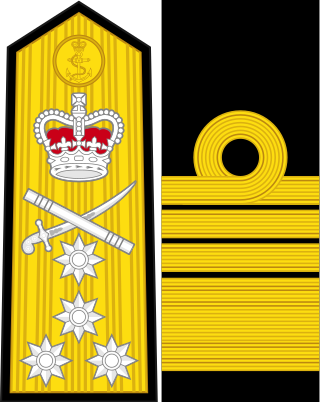
The Home Fleet was a fleet of the Royal Navy that operated from the United Kingdom's territorial waters from 1902 with intervals until 1967. In 1967, it was merged with the Mediterranean Fleet creating the new Western Fleet.

Admiral is a senior rank of the Royal Navy, which equates to the NATO rank code OF-9, outranked only by the rank of admiral of the fleet. Royal Navy officers holding the ranks of rear admiral, vice admiral and admiral of the fleet are sometimes considered generically to be admirals. The rank of admiral is currently the highest rank to which a serving officer in the Royal Navy can be promoted, admiral of the fleet being in abeyance except for honorary promotions of retired officers and members of the Royal Family.

The Commander-in-Chief, The Nore, was an operational commander of the Royal Navy. His subordinate units, establishments, and staff were sometimes informally known as the Nore Station or Nore Command. The Nore is a sandbank at the mouth of the Thames Estuary and River Medway. In due course the Commander-in-Chief became responsible for sub-commands at Chatham, London, Sheerness, Harwich and the Humber.
Commodore (Cdre) is a rank of the Royal Navy above captain and below rear admiral. It has a NATO ranking code of OF-6. The rank is equivalent to brigadier in the British Army and Royal Marines and to air commodore in the Royal Air Force. Commodore has only been a substantive rank in the Royal Navy since 1997. Until then the term denoted a functional position rather than a formal rank, being the title bestowed on the senior officer of a fleet of at least two naval vessels comprising an independent command.
Vice Admiral Norman Atherton Wodehouse was a Royal Navy officer killed in the Second World War. He had gained 14 caps for England at rugby union, including six as captain between 1910 and 1913. Wodehouse was acting as a convoy commodore when his ship was sunk by a German U-boat.

The East Indies Station was a formation and command of the British Royal Navy. Created in 1744 by the Admiralty, it was under the command of the Commander-in-Chief, East Indies.

The Commander-in-Chief South Atlantic was an operational commander of the Royal Navy from 1939. The South American area was added to his responsibilities in 1960, and the post disestablished in 1967.

The First Battlecruiser Squadron was a Royal Navy squadron of battlecruisers that saw service as part of the Grand Fleet during the First World War. It was created in 1909 as the First Cruiser Squadron and was renamed in 1913 to First Battle Cruiser Squadron. It participated in the battles of Heligoland Bight, Dogger Bank and the Battle of Jutland. After the end of the war it became the sole Battlecruiser Squadron.

Captain Ralph Kerr CBE was an officer in the Royal Navy. He served in the First and Second World Wars, and was killed in the sinking of HMS Hood by the German battleship Bismarck at the Battle of the Denmark Strait.
Admiral Sir William Hannam Henderson, was a British flag officer of the Royal Navy, and the first editor of The Naval Review.

Admiral Sir William Gerrard Andrewes was a Royal Navy officer who served in World War I and World War II, commanded the British and Commonwealth Naval Forces and Task Force 91 for the Inchon Landing during the Korean War, and went on to command of the America and West Indies Squadron and served as Deputy Supreme Allied Commander, Atlantic.

Vice Admiral Sir Edmund Walter Anstice, was a senior Royal Navy officer and aviator who served as Fifth Sea Lord from 1951 to 1954.

Admiral Adhar Kumar Chatterji was an Admiral in the Indian Navy. He served as the 6th Chief of the Naval Staff, from 4 March 1966, until 28 February 1970. He was the first Indian officer of the navy to hold the rank of full Admiral. He is credited with the transformation of the Indian Navy. He made sweeping changes and restructured the navy, creating the Western and Eastern Naval Commands and the Western Fleet. Under him, the Indian Navy also entered the submarine age, with the commissioning of INS Kalvari (S23) in 1967.
Admiral Sir Reginald Friend Hannam Henderson, was a British Royal Navy officer who was Captain Superintendent of Sheerness Dockyard 1899–1902, Admiral Superintendent of Portsmouth Dockyard 1902–1905, and Admiral Commanding, Coastguards and Reserves 1905–1909.

The Flag Officer, Royal Yachts, (FORY) also styled Flag Officer Commanding Royal Yachts was a senior Royal Navy post that existed from 1884 to 1997.

During the First World War, the Commander-in-Chief at the Cape, Rear Admiral Herbert King-Hall, expended much effort to destroy the elusive German light cruiser Königsberg.

The Black Sea and Caspian Squadron, also known as the Black Sea and Marmora Force and the Black Sea and Marmora Division, was a naval formation of the British Mediterranean Fleet from 1918 to 1919.

Rear Admiral Ajitendu Chakraverti was a Flag Officer in the Indian Navy. He served as the second Indian Flag Officer Commanding Indian Fleet, succeeding Rear Admiral Ram Dass Katari. He was the first Indian to be promoted to the high rank of Commodore in the Royal Indian Navy.


















